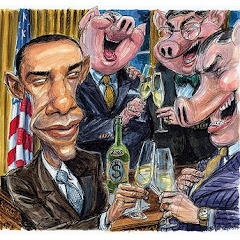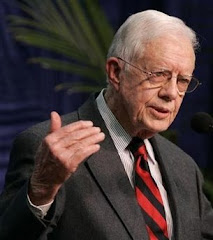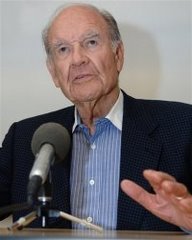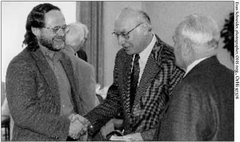Now that health care is in a complete mess and continual crisis doctors are for single-payer universal health care; for one selfish reason: MONEY. Doctors are having a hard time collecting on their exorbitant bills from unemployed workers and workers paid poverty wages, and now these doctors want Uncle Sam to subsidize their extravagant life-styles and become their collection agency to boot.
The solution is very simple… take these greedy doctors out of the picture just like the insurance companies, HMO’s and pharmaceutical companies along with private hospitals. The time has come to consider socialized health care.
We can get all the doctors we need in this country in a few years… just go through the ghettos, barrios and Indian reservations and offer any kid who wants to become a doctor a free education contingent upon doing well in high school. Guarantee these kids a $75,000.00 a year job, plus cost of living increases yearly upon completion of university.
Let the greedy, money grubbing doctors compete with this.
Here in Minnesota the health care plan being brought forward by Democratic State Senator John Marty will protect money grubbing doctors as the pharmaceutical companies, huge HMO’s and hospitals continue to profit as Minnesotans pay exorbitant premiums.
To the Democrats, Republicans and many Greens the free enterprise system of capitalism is the “cats meow.” The doctors purr; the patients pay.
Put the doctors to work for a public health care system just like public school teachers.
Many of those training doctors--- adjuncts--- don’t even receive a living wage as they scrimp from pay-check to pay-check trying to feed their kids and make ends meet… I have yet to hear any doctor voice any empathy.
The only way single-payer universal health care is going to succeed in this country is when it is seen as a temporary Band-Aid solution with socialized health care being the solution… the Canadian single-payer system, one of the best health care systems in the world, is now in trouble because these parasites have been milking the system… it will take socialized health care to maintain good quality health care for all in Canada, just like here in the United States.
We need to go into health care reform with our eyes wide open and fully aware that this rotten capitalist system has given rise to an equally rotten and corrupt health care system where it is pretty much futile to even expect that a working person will receive treatment appropriate for their disease or illness… arrogant doctors pursue a course of treatment” most profitable for them and now these greedy parasites who have more in common with the scam artists in real estate and brokerage firms want to protect their nice little racket. And that is all that health care in this country has become; one big racket. Next thing you know the local bookie will be looking for the government to bail them out when someone betting on the ponies happens to pick a long-shot.
Minnesota Democratic State Senator John Marty is putting forward a scam in place of real health care reform; Senator Marty's scam will protect the bloated incomes of greedy, parasitic doctors, and do nothing to help people requiring health care.
As this article states very clearly, these greedy doctors have been the primary impediment to real health care reform for over eighty years in this country and now they want the government to protect their incomes… not coincidentally, doctors are among the biggest contributors to the campaign coffers of these politicians.
Let us be very clear about something: Doctors as a group in this country have been among the most reactionary, anti-woman, racist, anti-labor, pro-big-business, pro-capitalist, warmongering elements in our society. Most doctors wouldn’t give Physicians for Social Responsibility the time of day. Doctors have traditionally been the “grassroots” of the Republican Party. Is this true of all doctors? Of course not… but, the majority of the doctors in this country have been, and are, among the most selfish and greediest grouping in our society--- seldom, if ever, demonstrating any kind of empathy for anyone else's problems.
Now is the time to tell doctors to “take a hike.” We can find young people who really care about people to train to become doctors… Cuba did it, and so can we. In fact, the Cubans are exporting health care all over the world just like Manitoba exports forest-fire fighters. What does the United States export? Capitalism: War, exploitation, rape of resources, greed and poverty… just what wealthy doctors invest in to make more money.
Are we trying to solve this health care mess in the interest of getting the sick well and keeping people in good health; or, in the interest of doctors looking to make big bucks?
When push comes to shove, H.R. 676 isn’t much better without considerable tweaking; but, then again, looking at John Conyers’ list of campaign contributors one finds a bunch of doctors… ditto for Senator John Marty.
For years I have been pointing out what the writer below has just discovered: that universal health care was part of the original "New Deal" package of reforms; dropped after the American Medical Association attacked socialized health care as a "Bolshevik plot" intended to destroy the free enterprise system.
The American people consistently rally to the defense of public education... there is no reason to believe the American people will be any less supportive of socialized health care.
Alan L. Maki
The Doctors' Revolt
Doctors, the traditional advocates for the medical
status quo, are increasingly in favor of major
reforms to the U.S. health-care system.
Roger Bybee
| July 1, 2008 |
http://www.prospect.org/cs/articles?article=the_doctors_revolt
Doctors have historically been the watchdogs of the U.S.
medical system, with the American Medical Association
scaring New Dealers into dropping national health
coverage from the Social Security Act and then the AMA
shredding Harry Truman's reform efforts in the late
1940s. But a new poll and other significant indicators
suggest that doctors are turning against the health-
insurance firms that increasingly dominate American
health care.
The latest sign is a poll published recently in the
Annals of Health Research showing that 59 percent of
U.S. doctors support a "single payer" plan that
essentially eliminates the central role of private
insurers. Most industrial societies -- including nations
as diverse as Taiwan, France, and Canada -- have adopted
universal health systems that provide health care to all
citizens and permit them free choice of their doctors
and hospitals. These plans are typically funded by a mix
of general tax revenues and payroll taxes, and essential
health-care is administered by nonprofit government
agencies rather than private insurers.
The new poll, conducted by Indiana University's Center
for Health Policy and Professionalism Research, shows a
sharp 10 percent spike in the number of doctors
supporting national insurance: 59 percent in 2007
compared to 49 percent five years earlier. This
indicates that more physicians are eager for systematic
changes, said Toledo physician Dr. Johnathon Ross, past
president of Physicians for a National Health Program.
"What this means is the usual bloc of anti-reform is
breaking up," he told The Toledo Blade. "These doctors
are looking in the eyes of sick [uninsured] patients
every day."
The poll results underscore mounting signs that doctors
are resenting the increasingly short leash on which they
are held by insurers and large hospital chains, the
current masters of American medicine. And, increasingly,
doctors seem to be showing support for a single-payer
system that would essentially eliminate for-profit
insurers and curb the power of big provider chains.
The ever-accelerating corporatization of health care is
producing a seismic shift in the way that doctors look
at universal health care. Doctors are experiencing an
extreme and relatively sudden loss of control at the
hands of insurers and hospital networks, while being
snowed under by paperwork and bureaucratic battles with
insurance companies over authorizations and payments.
Losing Faith in the System
Dr. Seth Foldy, a family physician and former health
commissioner for the City of Milwaukee, believes that a
decisive breakdown of the health-care system has changed
the perspective of many doctors. "We've had a virtual
recession over the last six years, with more people
unable to get insurance and more doctors not getting
paid," he states. "There is an overall sense that the
system doesn't work, and, worse, there's been no real
effort to fix it."
The statistics indeed suggest a major breakdown:
Premiums have climbed 87 percent since 2000, and
workers' meager pay raises have been far outstripped by
major increases in their share of the premiums. While
the U.S. ranks 37th on a variety of quality measurements
used by the World Health Organization, per-capita
spending in the U.S. is twice as high as any other
nation. For example, the U.S. spent $6,697 per person in
2005 compared with $3,326 in Canada. Meanwhile, the
sharply escalating costs in the U.S. are leading to
shrinkage of insurance coverage provided by employers.
Some 47 million Americans are uninsured, with the
present economic downturn certain to significantly
increase those numbers.
Among the most acute symptoms of the current crisis is
the rapidly declining share of employers who offer
insurance to their workers. In Wisconsin, for example,
73 percent of workers had health insurance through their
jobs in 1979, but by 2005, the share had plummeted to 58
percent. The Kaiser Family Foundation's annual survey
for 2007 shows that the percentage of employers offering
coverage has decreased by 9 percent since 2000, mostly
in firms with fewer than 50 workers.
As these trends have unfolded, coupled with growing
bureaucratic control by insurers and hospital chains,
many doctors have come to question whether for-profit
insurers need occupy such a central role in U.S. health
care.
State-level polls reinforce the just-released national
survey from Indiana's Center for Health Policy. A
remarkable 64 percent of the Minnesota doctors surveyed
in 2006 expressed support for a Canadian-style single-
payer system that would drive insurers from their
commanding role in the health system, reported Minnesota
Medicine. The Minnesota poll aligned closely with a
Massachusetts survey of doctors in 2004, which reflected
61 percent backing for single-payer, according to the
Archives of Internal Medicine. Doctors' views seem to be
coming into closer alignment with those of the general
public, of which 67 percent explicitly support a system
like Canada's or Britain's.
This finding among the members of Minnesota's Medical
Society -- an affiliate of the American Medical
Association (AMA) -- reflects a broader trend emerging
even among the members of the AMA, traditionally the
bulwark of those defending the medical status quo. In
1935, Franklin Delano Roosevelt wanted to include a
national health plan in the Social Security Act. But his
advisers persuaded him to omit inclusion of the health
provision, fearing that it would lead the AMA to sink
the entire Social Security project.
Similarly, when his successor Harry Truman outlined a
plan for national health care after the 1948 election,
the AMA opposed the plan despite 75 percent public
support for his proposal. The AMA ignited a highly
sophisticated, multilevel effort among its members and
business allies to block the "socialized medicine" plan
and politically crush its proponents, as professor Jill
Quadagno of Florida State University outlines in her
book, One Nation Uninsured. The Truman plan was soundly
defeated, and the AMA succeeded in unseating health-
reform champions like U.S. Reps. Andrew Biemiller of
Wisconsin and Sen. Claude Pepper of Florida, both from
"safe," staunchly Democratic areas.
But the AMA faces a vastly different landscape today.
Less than one-third of doctors belong to the AMA, as
physicians increasingly identify with organizations
based on their medical specialty. Moreover, despite the
AMA's harsh and incessant preaching against single-payer
health care as "socialized medicine" and its active
promotion of myths about "rationing" and "long waiting
lines" in single-payer nations, the group's own national
polling has shown a dramatic shift in its members' view
of reform over the past 15 years or so. Where only 18
percent of AMA members favored single-payer reform in
1992, the figure had soared to 42 percent by 2004.
Single-payer proved more popular than more modest
measures like public programs to cover the uninsured, an
individual mandate to purchase insurance, or an employer
mandate, according to the AMA's 2004 Advocacy Agenda
Setting Survey. Among some subgroups of the AMA, support
for single-payer was even stronger, reaching 58 percent
among psychiatrists. (Pediatric cardiologists showed a
70 percent level of support for single-payer in a 2003
poll of physicians published in the Annals of Internal
Medicine.)
Meanwhile, members of the American College of Physicians
-- the nation's second-largest doctors' organization
with 124,000 internal-medicine physicians and related
specialists -- voted in December 2007 to endorse the
single-payer idea. The vote followed an analysis of
health care in the United States and 12 other
industrialized countries, after which the ACP concluded
that universal coverage had been successfully attained
elsewhere through single-payer or mixed public/private
systems.
Ironically, the commanding role of for-profit insurers
and other corporate players has produced all the dire
effects that doctors were warned about as the products
of "socialized medicine," delivered instead by a system
that generates immense profits. "When doctors were
worried about the government looking over their
shoulder, now they actually have insurers second-
guessing everything we do," says Dr. Deborah Richter,
past president of Physicians for a National Health
Program and now a general practitioner in Cambridge,
Vermont.
"When doctors had a fear of bureaucracy, now they are
being hit with different demands from every insurer,"
Dr. Richter explains. "When doctors had a fear of losing
income, they're now facing declining reimbursements from
the insurers."
From Quadagno's perspective as a sociologist who has
studied the shifting contours of our nation's health
care, the complexity and failures of the current
corporate-driven system are central forces behind
doctors' changing views. "One big factor is having to
deal with so many companies, which creates huge
paperwork and headaches," Quadagno says. "And then
doctors either have to turn away the uninsured or
provide care for no compensation."
"The stock of the private sector has gone down in
doctors' eyes, while the stock of the public sector
hasn't," Foldy says. "Medicare is not unpopular among
doctors. The concept of Medicare for all [which is how a
single-payer plan is often described] is making
ideological headway. And prior to the Iraq War, the VA
system made great strides as a model of quality
recognized by many doctors."
Meanwhile, doctors' perceptions of the for-profit
insurance industry -- which ranks about as low as Big
Tobacco in the general public's eyes -- have declined as
premiums soar, bureaucratic problems multiply, and the
ranks of the uninsured grow. "There is much less trust
that the private-sector insurance companies will be good
partners in health care," Foldy says. "Doctors are
encountering a lot of problems with [insurance
companies], in honesty and uprightness around timely and
full payment. Doctors are facing a high denial rate when
they file claims."
Losing Control to Private Insurers
The high denial rate is the product of increasing
scrutiny of claims by a mushrooming private-sector
bureaucracy. As New York Times columnist Paul Krugman
has noted, "Between 2000 and 2005, the number of
Americans with private health insurance coverage fell by
1 percent. But over the same period, employment at
health insurance companies rose a remarkable 32 percent.
What are all those extra employees doing? ... They are
working harder than ever at identifying people who
really need medical care, and ensuring that they don't
get it."
Along with the denial of claims comes what Richter calls
the incessant "second guessing" by insurance company
staff. A survey by a physicians' group called Primary
Care Vermont found that doctors perceived insurers'
long-distance challenges to their judgments as a major
problem requiring constant, time-consuming wrangling.
"So you have an insurance clerk with a high school
education saying you can't do an MRI scan," Richter
says. "It's a steady drip, drip, drip. That takes away
from the care of the patient."
A whole new layer of intrusion into doctors' care of
their patients has cropped up in the form of "disease-
management programs," which Richter argues are chiefly
designed to generate more prescriptions for the
pharmaceutical industry. "There are now disease-
management program businesses, contracted by insurance
companies to deal with patients with chronic illnesses
like asthma, diabetes, or hypertension. These programs
are now bypassing the doctor and asking the patient to
request certain data or certain tests from their
doctors.
In one especially troubling case, Richter recalls, "one
of my patients got a letter just before the holidays
from a disease-management outfit saying he had
congestive heart failure. The letter spoiled his
holidays because he was worried he was going to die, and
when he finally came in to see me, he was mad at me for
not telling him about his condition." The patient
finally calmed down when Richter showed him that he did
not have the condition.
The level of bureaucratic complexity is nightmarish and
ongoing, says Richter. In a single day, she deals with
dozens of different insurance plans, each authorizing
treatments for different conditions and each denying
others. Moreover, each insurance plan has its own
"formulary" -- a list of approved drugs -- from which
doctors must prescribe in order to have the
pharmaceuticals covered by insurance. "With people who
are insured, you have to tailor what you do to the
insurance -- you have to change their prescription
according to the formulary," she says. "The new Medicare
Part D makes it worse, because there are 25 to 50
different plans. In any one day, I'm dealing with 30 to
40 different formularies."
Fighting over authorization for treatment is another
major issue, says Foldy, who specializes in working with
homeless psychiatric patients. "Surgeons probably hear
[denial of authorization] a lot more than I do. This was
even more of a problem earlier in the mid-1990s when
[for-profit, insurer-owned or influenced] HMOs were more
aggressive."
The mid-1990s were a period of extreme restrictions on
care, with employers viewing "managed care" as an
effective means of holding down premiums. For-profit
HMOs and insurers began pressuring hospitals to release
patients before they were well enough to take care of
themselves, as with "drive-through deliveries" where new
mothers were sent home within 24 hours after giving
birth.
"The [for-profit] HMOs have backed off some, and they've
shown themselves to be failures in holding down costs,"
Foldy says. When the HMOs were very rigid, employees
wanted their employers to change insurance companies.
"So the insurers decided that they would rather have
higher premiums and happier patients. The incentives
weren't aligned right to hold down premiums."
Heart surgeon Dr. Dudley Johnson, a renowned pioneer in
open-heart surgery who now specializes in high-risk
cardiac cases, has frequently encountered another form
of bureaucratic resistance from insurers. Insurers are
generally unwilling to refer patients outside the
hospital and clinic networks with which the insurers
have negotiated financial arrangements.
"In any number of cases, we've have to fight the
insurers, even when the patients' own doctors obviously
couldn't do the needed [specialized] surgery," Johnson
says. "Some of the patients would eventually get in.
Some of them never did get clearance, even though their
quality of life would be better with surgery as well as
their prospects for survival."
Doctors face severe pressures from their networks to
refer only within the network, Johnson says. "If your
doctor says a doctor outside your network is the best,
that doctor gets in a lot of trouble. The insurers and
networks are working in sync to get all the patients to
come to their hospital. They have people who check the
records to see to whom their doctors refer patients. So
you hear doctors say, 'I can't write it in the chart who
I'd recommend you to see.' There's a lot of pressure."
Such pressures have driven physicians like Johnson to
conclude that only a single-payer system can restore
patient care rather than profit as the core of the
health-care system. But even if the polls in Minnesota
and Massachusetts reflect a broad shift toward that
conclusion, single-payer advocates face the task of
converting individual opinion into effective collective
action.
Reform Movement Gaining Momentum
For activists like Richter, that means, first of all,
helping doctors to discover that they are not alone in
their alienation from the medical status quo. "Doctors
are complaining but don't realize how unhappy other
doctors are," she says. To break through this sense of
isolation, Richter has given presentations on the need
for single-payer reform at every hospital in the state
of Vermont. The response now is markedly different from
a few years back. "The crowds are bigger and the heads
are nodding in agreement," she says.
Richter readily concedes the difficulty of organizing
doctors, who spend much of their time working alone and
often either absorbed in building up a new practice or
preparing for retirement. "They say organizing doctors
is like herding cats. It's tough to get them to join
forces," Richter admits. "I don't see organized medicine
joining to lead the fight now, but eventually they'll
get on the bandwagon."
Quadagno is less optimistic based on her studies of the
episodic upsurges for health-care reform in the U.S. and
the current lineup of forces in the U.S. "Different
organizations have different stances, and there isn't
any unified force," she says. "Unions are now less
unified and less powerful than in the past. And then you
see the AFL-CIO's energy going into efforts like 'fair
share' initiatives to make Wal-Mart cover its employees
rather than pushing for universal care, such as a
single-payer plan."
While pro-reform sentiment may be building among
doctors, single-payer advocates will eventually face the
fierce and well-funded opposition of the for-profit
insurers and their allies like the drug companies (who
fear that a single-payer system will bring on
negotiations with the government overpricing, thereby
slicing their profits). "Insurers have the capacity to
do more than any doctors' group," Quadagno says
ruefully. "I don't think a single-payer plan can win."
In contrast, Richter is much more optimistic based on
her direct organizing experience and listening to
doctors' alienation from the fast-advancing
corporatization of health care. Although she's keenly
aware of the insurer-and-pharma coalition's influence,
Richter believes that the insurers will continue to
aggravate the grievances of both doctors and patients
alike. For example, the insurance industry's hiring
explosion will continue to mean more exasperating fights
for doctors seeking payment for their services, and for
the general public trying to get its bills paid. The
public's approval rating of the insurers is likely to
drop further.
Additionally, doctors are growing particularly inflamed
by the trend for "medical tourism." This term refers to
the outsourcing of medical surgeries, just as major
firms have been outsourcing both factory and white-
collar work to low-wage nations. "More and more
insurance companies are paying patients to go to places
like India for hip and knee replacements, bypass
surgery, and other operations," Richter says. There were
150,000 medical-tourist operations last year. It started
with cosmetic surgery, but now medical tourism has
really expanded because insurers can pay just one-tenth
or one-twentieth the cost they do here. Richter
predicts, "That may finally bring along the surgeons,"
who have been less inclined to fight for reform.
Given the enormous political clout of the medical
insurers and allied health-care interests, winning
single-payer health care in the United States is certain
to be an arduous and lengthy fight. But the heightening
conflicts between doctors and insurers and hospital
chains, along with the AMA's declining importance, has
made a significant swath of the medical profession far
more sympathetic to the single-payer option than
advocates would have dared to dream just a few years
ago.











































































































